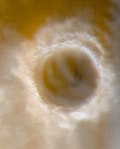North Polar Basin (Mars)
The Borealis Basin, or the North Polar Basin, is a large depression or basin in the northern hemisphere of Mars. The North Polar Basin takes up 40% of the Martian surface.[1] It has a diameter of about 9,500 km (5,900 miles), but is slightly stretched, or elliptical, meaning its true size is closer to 10,600 km (6,600 mi) by 8,500 km (5,300 mi).
An explanation for the basin's low, flat and relatively crater-free structure is that the basin was formed by a single large impact.
Simulations suggest that a body of about 0.02 Mars masses (~0.002 Earth masses, about the size of Pluto) can produce a sizable debris disk in Martian orbit, on the order of 500 quadrillion tonnes, with much of the material remaining close to Mars. Scientists think this could have formed Phobos and Deimos.
Analysis of Mars Global Surveyor data found mineral deposits similar to terminal moraines on Earth along the southern rim of the northern low land, giving evidence that an asteroid caused a tsunami in the basin.
Even though it's so large, the basin is not yet called an impact basin by the IAU because scientists aren't sure if it's actually the site of an impact. The basin is one of the flattest areas in the Solar System. The landing site of the Viking 1 lander is a bay that opens into the basin.
North Polar Basin (Mars) Media
References
- ↑ "NASA - NASA Spacecraft reveal largest crater in Solar System". www.nasa.gov. Archived from the original on 2020-08-04. Retrieved 2017-04-06.


